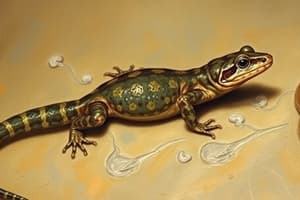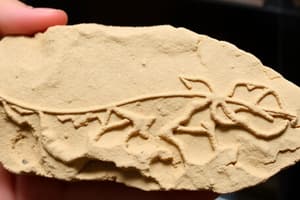Podcast
Questions and Answers
What is Phylum PORIFERA?
What is Phylum PORIFERA?
- Marine bivalve, filter feeding, bilateral symmetrical
- Aquatic, sessile, colonial
- Sponges, single or colonial, composed of siliceous or calcareous spicules that fuse together (correct)
- 5 fold symmetry with body composed of plates with spines
What bodies are composed of two layers enclosing a central cavity?
What bodies are composed of two layers enclosing a central cavity?
Phylum CNIDARIA
What class do corals belong to?
What class do corals belong to?
Class ANTHOZOA
What distinguishes Order TABULATA?
What distinguishes Order TABULATA?
What defines Order RUGOSA?
What defines Order RUGOSA?
How are septa arranged in Order SCLERACTINIA?
How are septa arranged in Order SCLERACTINIA?
What is Phylum BRYOZOA known for?
What is Phylum BRYOZOA known for?
What characterizes Phylum BRACHIOPODA?
What characterizes Phylum BRACHIOPODA?
What defines Phylum MOLLUSCA?
What defines Phylum MOLLUSCA?
What is Class GASTROPODA characterized by?
What is Class GASTROPODA characterized by?
What describes Class BIVALVIA?
What describes Class BIVALVIA?
What defines Class CEPHALOPODA?
What defines Class CEPHALOPODA?
What is the characteristic of Subclass NAUTILOIDEA?
What is the characteristic of Subclass NAUTILOIDEA?
What distinguishes Subclass AMMONOIDEA?
What distinguishes Subclass AMMONOIDEA?
What is unique about Subclass COLEOIDEA?
What is unique about Subclass COLEOIDEA?
What describes Phylum ANNELIDA?
What describes Phylum ANNELIDA?
What is a defining feature of Phylum ARTHROPODA?
What is a defining feature of Phylum ARTHROPODA?
What is characteristic of Class TRILOBITA?
What is characteristic of Class TRILOBITA?
What defines Class CIRRIPEDIA?
What defines Class CIRRIPEDIA?
What characterizes Phylum ECHINODERMATA?
What characterizes Phylum ECHINODERMATA?
What is unique about Subphylum CRINOZOA?
What is unique about Subphylum CRINOZOA?
What does Class CRINOIDEA have?
What does Class CRINOIDEA have?
What characterizes Subphylum BLASTOZOA?
What characterizes Subphylum BLASTOZOA?
What distinguishes Class BLASTOIDEA?
What distinguishes Class BLASTOIDEA?
What defines Class RHOMBIFERA?
What defines Class RHOMBIFERA?
What does Subphylum ECHINOZOA include?
What does Subphylum ECHINOZOA include?
What characterizes Class ECHINOIDEA?
What characterizes Class ECHINOIDEA?
What is unique about Subphylum ASTEROZOA?
What is unique about Subphylum ASTEROZOA?
What does Class ASTEROIDEA represent?
What does Class ASTEROIDEA represent?
What characterizes Class OPHIUROIDEA?
What characterizes Class OPHIUROIDEA?
What are Unaltered Body Fossils?
What are Unaltered Body Fossils?
What are Altered Body Fossils?
What are Altered Body Fossils?
What is recrystallization?
What is recrystallization?
What occurs during replacement?
What occurs during replacement?
What is permineralization?
What is permineralization?
What are molds?
What are molds?
What are casts?
What are casts?
What is carbonization?
What is carbonization?
What are trace fossils?
What are trace fossils?
What are tracks in trace fossils?
What are tracks in trace fossils?
What are trails in trace fossils?
What are trails in trace fossils?
What are burrows in trace fossils?
What are burrows in trace fossils?
What are coprolites?
What are coprolites?
Flashcards are hidden until you start studying
Study Notes
Phylum PORIFERA
- Comprises sponges, either single or colonial.
- Built from siliceous or calcareous spicules that fuse together.
Phylum CNIDARIA
- Characterized by bodies with two layers surrounding a central cavity.
- Includes class ANTHOZOA with suborders TABULATA, RUGOSA, and SCLERACTINIA.
Class ANTHOZOA
- Encompasses corals and various orders such as TABULATA, RUGOSA, and SCLERACTINIA.
Order TABULATA
- Features corallites partitioned by transverse tabulae and lacks septa.
- Extinct order within phylum CNIDARIA and class ANTHOZOA.
Order RUGOSA
- Identified by four primary septa, with secondary septa developing as they mature.
- This order is also extinct and part of phylum CNIDARIA and class ANTHOZOA.
Order SCLERACTINIA
- Contains corals with septa arranged in sets of six or multiples of six.
- Part of phylum CNIDARIA and class ANTHOZOA.
Phylum BRYOZOA
- Comprises aquatic, sessile, and colonial organisms.
Phylum BRACHIOPODA
- Marine bivalves that filter feed; exhibit bilateral symmetry.
Phylum MOLLUSCA
- A diverse group having a muscular foot, often with a hard unsegmented shell.
- Main classes include GASTROPODA, BIVALVIA, CEPHALOPODA, subdivided into NAUTILOIDEA, AMMONOIDEA, and COLEOIDEA.
Class GASTROPODA
- Features a distinct trochoidal spiral shape.
- Belongs to phylum MOLLUSCA.
Class BIVALVIA
- Represents bivalves where the top and bottom valves are mirror images.
- Associated with phylum MOLLUSCA.
Class CEPHALOPODA
- Known for a bilaterally symmetrical body with a head and tentacles.
- Contains subclasses NAUTILOIDEA, AMMONOIDEA, and COLEOIDEA.
Subclass NAUTILOIDEA
- Characterized by a segmented, uncoiled or planispiral shell with simple sutures.
Subclass AMMONOIDEA
- Features a segmented, ornate shell with intricate sutures.
Subclass COLEOIDEA
- Shell is greatly reduced or absent, which includes modern cephalopods like squid and belemnoids.
Phylum ANNELIDA
- Represents segmented worms equipped for burrowing.
Phylum ARTHROPODA
- Distinguished by a segmented exoskeleton, jointed limbs, and bilateral symmetry.
- Includes superclass TRILOBITOMORPHA (class TRILOBITA) and superclass CRUSTACEA (class CIRRIPEDIA).
Class TRILOBITA
- Known as trilobites with a tripartite body structure and bilateral symmetry.
Class CIRRIPEDIA
- Comprises barnacles characterized by a fused head and body.
Phylum ECHINODERMATA
- Exhibits five-fold symmetry and a body formed from plates with spines.
- Contains various subphyla including CRINOZOA, BLASTOZOA, and ECHINOZOA.
Subphylum CRINOZOA
- Includes sessile organisms attached to the sea floor by a tubular, segmented stem.
- Calyx may separate post-mortem due to decay.
Class CRINOIDEA
- Recognized by a long stem and numerous brachioles or arms on the calyx.
Subphylum BLASTOZOA
- Sessile, attached organisms with a tubular, segmented stem and fused theca plates, preserving head integrity after death.
Class BLASTOIDEA
- Blastoids with a short stem and symmetrical arrangement of plates and arms.
Class RHOMBIFERA
- Primitive relatives of blastoids with irregular plate arrangement.
Subphylum ECHINOZOA
- Comprises sea urchins that are motile and feature five plates.
Class ECHINOIDEA
- Represents sea urchins, sea biscuits, and sand dollars.
Subphylum ASTEROZOA
- Characterized by motility and a star-shaped morphology.
Class ASTEROIDEA
- Known as starfish, lacking a central body.
Class OPHIUROIDEA
- Includes brittle stars with a distinct central body.
Unaltered Body Fossils
- Fossils where the complete organism is preserved, retaining all original hard and soft parts.
Altered Body Fossils
- These fossils maintain the original body form but have undergone changes in chemical composition.
- Methods include recrystallization, replacement, and permineralization.
Recrystallization
- A metamorphic process resulting in new crystal structures due to high temperature and pressure.
Replacement
- Occurs when organic tissues, such as shells or bones, are substituted with other minerals.
Permineralization
- A fossilization process where mineral deposits create internal casts of organisms.
Molds
- Cavities leftover when organic materials dissolve, retaining only external impressions.
Casts
- Detailed representations of an organism's surface features formed from mineralization.
Carbonization
- Results in an outline of organisms preserved in carbon residue.
Trace Fossils
- Identifiable marks made by organisms, including tracks, trails, burrows, and coprolites.
Tracks (Trace Fossils)
- Represent footprints of organisms.
Trails (Trace Fossils)
- Continuous marks created by dragging movement.
Burrows (Trace Fossils)
- Holes made for habitation or movement.
Coprolites (Trace Fossils)
- Preserved fecal matter, providing insights into diet and behavior.
Studying That Suits You
Use AI to generate personalized quizzes and flashcards to suit your learning preferences.




